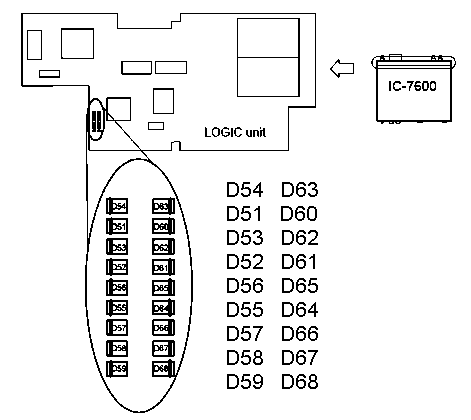Icom IC-7600
The Icom IC-7600 covers the 160 to 6 meter amateur bands. It utilizes IF-DSP technology and selectable roofing filters at 3kHz, 6kHz and 15kHz. Like the IC-7700 and IC-7800, the IC-7600 uses dual 32-bit floating-point Texas Instruments DSP chips with one for the radio and the other for the spectrum scope. This display is a 5.8 inch color WQVGA LCD.
Status: Currently on the market as of 2017, still in production. Replaces the Icom IC-756 Family of transceivers.
- Receive Range 1: 0.030-60.000 MHz
- Receive System: Single receiver
- Dual Watch: Yes
- Roofing Filter Capability: Yes
- Roofing Filter Bandwidth: 15/6/3kHz
- Third Order Intercept (IP3): Over 30 dBm
- Transceiver Input Voltage: 13.8 Vdc
- Transceiver Maximum Current: 23.0 A
- Antenna Ports: 2
- Computer Connection Type: USB or CI-V interface
- Digital Mode Audio Input/Output: USB or 8-pin DIN
- Voice Synthesizer Capability: Yes
- Radio Dimensions: Width 13.375", Height 4.563", Depth: 11.000"
- Weight: 22.000 lbs.
- SSB/CW Maximum Power: 100 W
- SSB/CW Minimum Power: 2 W
- AM Maximum Power: 30 W
- AM Minimum Power: 1 W
Contents
Ver.2.00 Firmware
Tip: The first time you update, thoroughly read the Section 14 (UPDATING THE FIRMWARE) of the IC-7600’s instruction manual and information for firmware 2.00 on Icom Co. Support page. The firmware can be updated using a USB-flash drive.
Some new features:
- point and click the mouse for Click-and-Listen receiver control.
- Waterfall screens
- additional functions added to the spectrum scope
- APF AF Level setting
- CI-V commands for antenna control, logging software and RIT/DELTA-TX
- TX Delay (HF/50M) settings for variable delay time
- Standby setting to remotely turn ON the IC-7600 using the REMOTE jack.
- MOS-FET is now the default value of SEND Relay Type
MARS / Extended Transmit and Receive
MARS/CAP Mod: IC-7600
RX Frequency Coverage Expansion
- remove D52, D53, D54, and D55
TX Frequency Coverage Expansion
- remove D56, D57, D58, and D59
offers: 1.6 - 30MHz and 51 - 54 MHz
5MHz Band Operation
- remove D62
offers: 5.255 - 5.405 MHz
Non-Icom Amplifier Connection
The ALC input level must be in the range 0 V to – 4 V. The transceiver does not accept positive volt-age. SEND RELAY type menu item (in the ACC set mode menu) which allows selection of the OMR-109F relay (LEAD) or a MOSFET interface (MOS-FET). The MOSFET option is rated at 250V/0.2A AC/DC, non-inductive. If the amplifier's open-circuit keying-line voltage is above 16V but below 250V, this option can be selected.
ACC set mode
Send Relay Type: Selects the switching relay type for [RELAY] from Lead and MOSFET. Select the suitable relay type when connecting a non-Icom linear amplifier.
- Lead - Use mechanical relay. (16 V DC/0.5 A max.; default)
- MOS-FET - Use semiconductor type relay. (250 V/200 mA max.)
Menu: SET -> ACC -> SEND Relay Type
The IC-7600 can key an amplifier circuit up to 250Vdc at 200 mA, select the correct keying mode via the ACC set menu.
With the Firmware Update Version 2.00 “MOS-FET” is now the default value of “SEND Relay Type.”
Use with SB-200 / SB-221 Amplifier
So, theoretically, you can use the IC-7600 with your old Heathkit amplifier without the Harbach Soft-Key interface as long as you use the MOS-FET ACC mode. However, you are better off if you go ahead and install the Soft-Key interface. If you have the Soft-Key interface installed, thus reducing the key line to approximately 0.7VDC at 1.5mA, then you will want to use the Lead ACC mode.
The recommended configuration: Use Harbach Electronics SK-220 Soft-Key Keying Interface and on the Icom ic7600 ACC set mode = Lead.
Accessories
- LDG M-7600 External Meter


